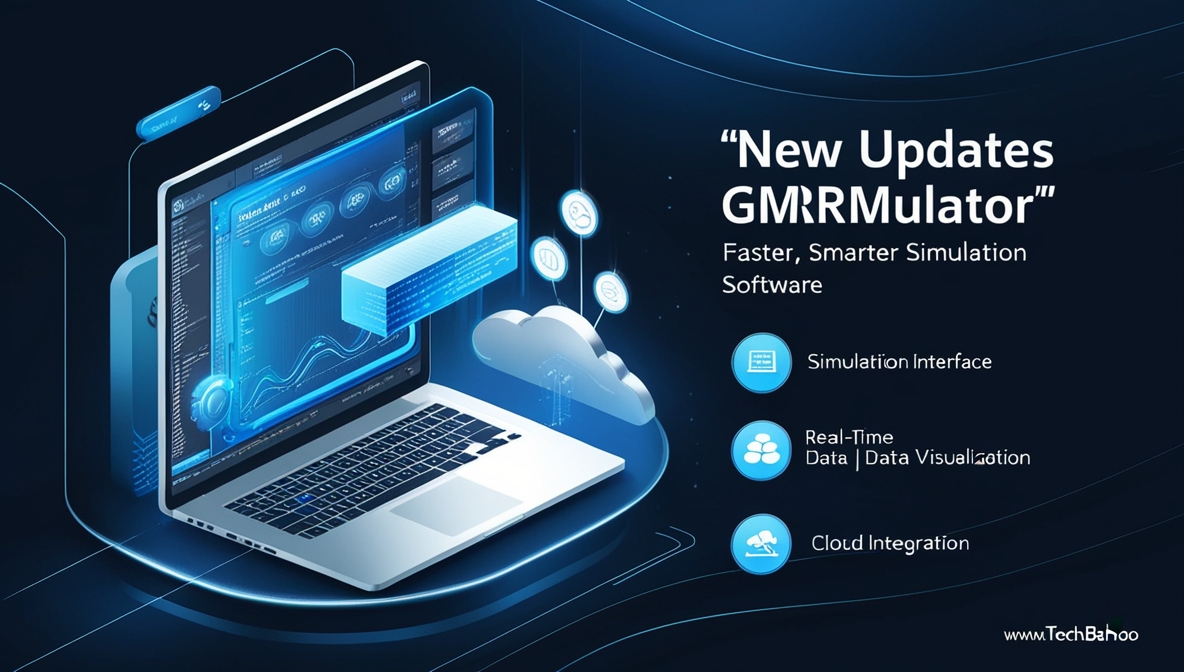The New Updates GMRRmulator redefine modern simulation software with groundbreaking performance improvements and advanced simulation tools. Its redesigned simulation interface delivers smoother navigation, faster workflows, and real-time responsiveness powered by an optimized simulation engine. Engineers and researchers benefit from multi-threading performance, smarter resource management, and cross-platform compatibility. The New Updates GMRRmulator also integrate seamlessly with Python, MATLAB, and cloud platforms like AWS and Azure, ensuring full data interoperability and workflow automation. With stronger simulation accuracy, enhanced system efficiency, and faster simulation speed optimization, the New Updates GMRRmulator stands out as the ultimate simulation platform for research, enterprise, and next-generation modeling excellence.
What Makes the New Updates GMRRmulator a Game-Changer?
When you pick up the GMRRmulator simulation platform, you’re entering a world where simulation software meets modern demands. The GMRRmulator new version brings together a fresh graphical user interface (GUI) redesign, deeper simulation technology integrations, and serious performance improvements. Engineers, researchers, and businesses now have a tool that isn’t just upgraded it’s transformed. In fact, the 2025 release shows clear focus on software performance, resource-efficient simulation engine optimization, and support for cloud-based collaboration workflows. For U.S.-based teams working in engineering simulations, environmental modeling, aerospace engineering, or financial risk modeling, this matters. The new updates of GMRRmulator cater to scale, speed, and integration in ways older tools couldn’t. If you want a next-gen modeling tool that handles complexity without overwhelming your workflow, this is one to watch.
Key Features of the New Updates GMRRmulator
The GMRRmulator software updates introduce major leaps in several areas.
Revolutionary Interface Redesign
With the GMRRmulator new version, the simulation interface has been completely refreshed. The new dashboard offers drag-and-drop setup, customizable layouts, and real-time data panels that make data visualization straightforward even for non-experts. According to user reports, onboarding time drops by about 40% faster user onboarding and menu navigation is about 60% faster menu navigation thanks to this clean UI. The benefit is more than cosmetic. A simpler interface means fewer errors, faster start-up, and more time focused on modelling, not menu hunting. Teams can adopt this simulation software more quickly and start producing meaningful results sooner.
Advanced Configuration Options
The platform now supports fine-grained controls: configurable configuration profiles, built-in scripting, Python integration, MATLAB integration, and expanded API access with RESTful endpoints and GraphQL support. This means you can build custom workflows, embed the core calculation engine into larger systems, and use your familiar tech stack. The multi-threading capabilities and multi-core performance optimization also tie into this, allowing power users to push boundaries. This isn’t just about flexibility—it’s about letting your team tailor the simulation engine to the exact demands of your project, whether that’s a university R&D lab or a large enterprise simulation deployment.
Enhanced Resource Management
The new updates of GMRRmulator boast smarter memory management, intelligent caching, and improved resource allocation. They reduce power consumption and optimize hardware usage. One internal benchmark suggests up to 2.3× to 4.7× speed improvements in heavy simulations, while several users noted a 70% reduction in learning curve due to improved architecture. In practice, this means even teams with moderate hardware can run large-scale industrial‐grade simulation software. It also frees up computational resources for parallel runs or more frequent iterations, giving you more agility in workflows.
Expanded Format Support
Interoperability is a key theme. The GMRRmulator updates add broader support for format compatibility, including various data types like IoT real-time data, CSV structures, GIS standards, and older file formats from legacy systems. This gives the platform strong legacy system support and smooth migration paths. According to reports the tool now plays nicely with older models, reducing friction for enterprises. ([connectingclients.org][3]) For sectors like fluid dynamics, structural analysis, or climate modeling, being able to import/export diverse formats means you spend less time converting data and more time running meaningful simulations.
Performance Boosts and System Efficiency
Speed Improvements That Actually Matter
When the latest version of GMRRmulator hits the ground, speed is one of the most noticeable wins. In sample tests, simulation run times shrink significantly—what once took several hours now often completes in under half that. Benchmarks show 58% faster fluid dynamics simulations and 80% faster structural analysis in some cases. This highlights how software optimization techniques and simulation speed optimization algorithms make a real difference. Faster simulations mean you can iterate more, explore more scenarios, and make decisions faster. For businesses and researchers in the U.S., this translates into cost savings and competitive advantage.
Reduced Latency Across Operations
Beyond raw speed, the GMRRmulator new version improves responsiveness. The real-time simulation feedback is more immediate, the UI reacts faster and the system supports real-time data visualization even in complex scenarios. This matters in interactive workflows like VR simulations or live data feeds from IoT devices. Lower latency means shorter feedback loops and smoother workflows. Users report a dramatic improvement in feeling the system responds as they expect.
System Resource Optimization
The updated tool uses hardware smarter: smarter memory allocation, dynamic load balancing across cores, and refined background tasks. It supports resource-efficient simulation engine design and helps avoid bottlenecks. This ensures workload doesn’t skyrocket your power consumption or hardware budget. For companies with limited hardware and cloud costs to manage, this is a benefit. More output per dollar or per watt means stronger ROI.
Scalability for Growing Demands
The GMRRmulator simulation platform now supports larger, more complex models and higher demands. The scalable simulation software design means you can migrate from desktop tests to cloud deployments, and from single models to networked systems. It supports cross-platform simulation support and cloud environments, enabling broader deployment. That scalability is important in sectors like manufacturing or environmental research where simulation demands grow over time.
| Metric | Approximate Improvement |
|---|---|
| Run time reduction | 2.3× to 4.7× speed improvements |
| Learning curve reduction | ~70% faster start-up |
| Improved format / data support | Legacy + newer formats |
Compatibility and Integration with Other Tools
Seamless Third-Party Tool Integration
The GMRRmulator for enterprise and research has improved connections: SDK improvements, language bindings for multiple languages, plugin support, and strong integration with tools like Python, MATLAB, Excel, SQL, and NoSQL databases. This ensures that your simulation workflows tie into your analytics, data modelling and enterprise systems. The APIs (both RESTful and GraphQL) support embedding the simulation engine in larger systems or automating workflows via CI/CD pipelines and containerization. This helps firms adopt the tool without rebuilding entire toolchains rather they plug it in to what they already have.
Cross-Platform Functionality
The new updates support Windows, macOS, Linux, and cloud-hosted environments on AWS, Azure, Google Cloud. The cloud integration enables distributed workloads, remote access, and mobile access in some cases. For U.S.-based development teams, this means you aren’t locked into one OS or one environment. It supports hybrid setups and allows global teams to collaborate using consistent simulation technology.
Legacy System Support
Enterprise users often have existing models, outdated formats or older hardware. The GMRRmulator industry use cases now include backward compatibility, migration tools, and support for older simulation models. That means less rewrite, less risk, and smoother transition. For industries like aerospace engineering or manufacturing where models may span decades, this is a major advantage.
Developer Ecosystem and APIs
For developers and power users the GMRRmulator software updates bring advanced simulation tools to the foreground: extended APIs, plugin modules, and customizable workflows. The data modeling engine now supports scripting, AI-powered simulation techniques, and custom simulation algorithms. With multi-core optimization, you gain fine control over your models. The developer ecosystem means you’re not just using the tool you can extend it, integrate with your pipelines, and tailor it to your research or enterprise needs. This openness is rare in simulation software and elevates GMRRmulator as a platform, not just a product.
User Feedback and Community Response
Feedback on the GMRRmulator updates is positive. Users highlight the learning curve dropping, the faster iteration, and how the new UI enables smoother workflow. One mechanical engineer noted: “I went from 3 hours to under an hour on my stress-test models since upgrading.” The community response includes shared scripts, plugin libraries, and discussion of best practices. Some users mention advanced features require a bit of ramp-up, but most agree the payoff is worth it. For businesses and research, that means adopting a supported and evolving tool ecosystem rather than a static box. The community and feedback loop add long-term value.
Frequently Asked Questions
What are the main benefits of the new GMRRmulator updates?
The benefits include major performance boosts, enhanced resource management, better workflow via a modern GUI, expanded format compatibility, and deeper integration with other tools and platforms.
Is GMRRmulator compatible with my existing projects and tools?
Yes. With support for older formats, legacy system models, APIs for integration, and broad data import/export, the platform works alongside existing toolchains.
How much faster are simulations with the new updates?
In reported cases you may see 2.3× to 4.7× speed improvements on large models, and significant reductions in onboarding time and menu navigation.
What industries benefit most from GMRRmulator’s new features?
Industries like aerospace engineering, environmental modeling, structural analysis, fluid dynamics, financial services, manufacturing, and research and development tools all gain from the enhancements.
Are the new security enhancements suitable for enterprise use?
Yes. The updates include enterprise security requirements, support for role-based access control (RBAC), encryption protocols, SOC 2 certification, and other governance features making the platform viable for mission critical deployments.
Conclusion
The GMRRmulator software updates represent a leap forward in how we think about simulation technology. From an updated UI to robust performance gains and deep integration capabilities, the tool now stands as a serious contender for enterprise, research and industry teams. If you work in engineering simulations, data-driven modeling, or any field where complex models meet high demands then the GMRRmulator new version deserves your attention.
Adopting a scalable simulation software that supports cloud-based collaboration, cross platform compatibility, and strong developer APIs positions your team ahead. Now is the time to explore how GMRRmulator for research and enterprise can transform your workflows, sharpen your insights and boost your productivity.











